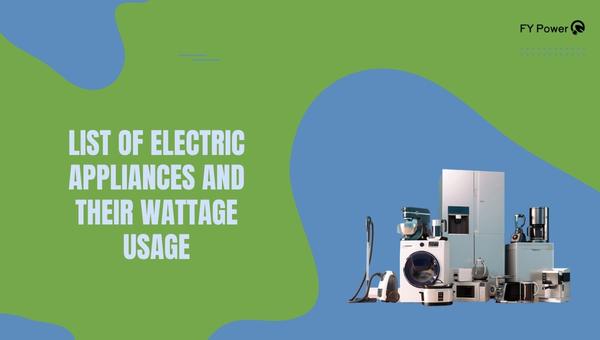Understanding the energy consumption of different electrical appliances can provide insight into how you can manage your electricity use more efficiently. It can help identify which appliances use the most energy, providing opportunities to reduce usage and save on electricity bills. This list provides an overview of various common electric appliances and their wattage usage.
Please note that wattage can vary based on factors such as the make and model of the appliance, its age, and how it’s used. It’s also essential to remember that the actual energy usage (measured in kilowatt-hours) is a function of both the appliance’s power (in watts) and the length of time it’s used.

All Essential Home Electric Appliances And Their Wattage Usage
Here’s a list of common essential home appliances and their average wattage. Remember that actual wattage can vary based on the specific model and how you use the appliance.
| Appliances | Average Wattage (W) |
|---|---|
| Refrigerator | 150-200 |
| Freezer | 150-200 |
| Electric Oven | 1000-5000 |
| Microwave | 600-1200 |
| Dishwasher | 1200-2400 |
| Toaster | 800-1500 |
| Electric Kettle | 1000-1500 |
| Coffee Maker | 600-1200 |
| Blender | 300-1000 |
| Electric Stove Burner | 1000-3000 |
| Washing Machine | 500-1000 |
| Clothes Dryer | 1800-5000 |
| Iron | 1000-1800 |
| Hair Dryer | 1000-1875 |
| Vacuum Cleaner | 500-2000 |
| Television | 50-400 |
| Computer | 100-800 |
| Laptop | 20-75 |
| Air Conditioner | 900-5000 |
| Space Heater | 750-1500 |
| Ceiling Fan | 65-175 |
| LED Light bulb | 8-12 |
| Incandescent bulb | 60-100 |
Please note that this table presents averages; actual wattages can be higher or lower. Energy Star-rated appliances, for example, often use less energy than the averages listed above. Always check the specific energy consumption information provided by the manufacturer of your appliances.
All Possible Laundry Appliances With Their Estimated Wattage
Here’s a list of common laundry appliances and their average wattage. Remember that actual wattage can vary based on the specific model and how you use the appliance.
| Appliances | Average Wattage (W) |
|---|---|
| Washing Machine | 500-1000 |
| Clothes Dryer (Electric) | 1800-5000 |
| Clothes Dryer (Gas) | 300-400 (for the electrical component) |
| Iron | 1000-1800 |
| Steam Iron | 1200-2000 |
| Clothes Steamer | 1200-1800 |
| Sewing Machine | 75-100 |
| Handheld Fabric Steamer | 800-1200 |
Please note that the table presents averages, and actual wattages can be higher or lower. The wattage for gas clothes dryers only indicates the power usage of the electrical component and does not account for the gas used in heating. Always check the specific energy consumption information provided by the manufacturer of your appliances.
All Possible Kitchen Appliances With Their Estimated Wattage
Here’s a list of common kitchen appliances, along with their average wattage. As always, remember that the actual wattage can vary based on the specific model and how you use the appliance.
| Appliances | Average Wattage (W) |
|---|---|
| Refrigerator | 150-200 |
| Freezer | 150-200 |
| Electric Oven | 1000-5000 |
| Microwave | 600-1200 |
| Dishwasher | 1200-2400 |
| Toaster | 800-1500 |
| Electric Kettle | 1000-1500 |
| Coffee Maker | 600-1200 |
| Blender | 300-1000 |
| Electric Stove | 1000-3000 per burner |
| Toaster Oven | 1200-1800 |
| Slow Cooker | 70-250 |
| Food Processor | 400-1000 |
| Stand Mixer | 250-500 |
| Hand Mixer | 100-200 |
| Juicer | 500-1000 |
| Rice Cooker | 450-1000 |
| Deep Fryer | 1200-2200 |
| Electric Grill | 1200-2000 |
Please note that the table presents averages, and actual wattages can be higher or lower. Always check the specific energy consumption information provided by the manufacturer of your appliances.
All Possible Entertainment Appliances With Their Estimated Wattage
Here’s a list of common entertainment appliances, along with their average wattage. Remember that actual wattage can vary based on the specific model and how you use the appliance.
| Appliances | Average Wattage (W) |
|---|---|
| Television (LED) | 30-100 |
| Television (LCD) | 50-200 |
| Television (Plasma) | 100-400 |
| DVD Player | 10-20 |
| Blu-ray Player | 15-30 |
| Game Console | 30-200 |
| Soundbar | 20-50 |
| Home Theater System | 200-500 |
| Stereo Receiver | 100-400 |
| Projector | 150-800 |
| CD Player | 15-30 |
| Radio | 50-200 |
| Desktop Computer | 100-800 |
| Laptop | 20-75 |
| Modem/Router | 5-20 |
| Streaming Device | 2-15 |
Please note that the table presents averages, and actual wattages can be higher or lower. Always check the specific energy consumption information provided by the manufacturer of your appliances.
All Other Home Electric Appliances With Their Estimated Wattage
Here are some additional common home appliances, along with their average wattage. As always, actual wattage can vary based on the specific model and how you use the appliance.
| Appliances | Average Wattage (W) |
|---|---|
| Air Conditioner | 900-5000 |
| Space Heater | 750-1500 |
| Dehumidifier | 200-800 |
| Electric Blanket | 75-100 |
| Hair Dryer | 1000-1875 |
| Curling Iron | 20-50 |
| Straightening Iron | 50-150 |
| Electric Toothbrush | 1-5 |
| Ceiling Fan | 65-175 |
| Box Fan | 50-100 |
| Desk Fan | 10-25 |
| Sewing Machine | 75-100 |
| Vacuum Cleaner | 500-2000 |
| Electric Lawn Mower | 500-1500 |
| Power Drill | 600-960 |
| Garage Door Opener | 500-750 |
| Electric Water Heater | 4000-5500 |
| Sump Pump | 800-1500 |
| Electric Shaver | 15-20 |
| Electric Fireplace | 750-1500 |
| Incandescent Light bulb | 60-100 |
| CFL Light bulb | 15-40 |
| LED Light bulb | 8-12 |
| Wi-Fi Router | 5-20 |
Again, please note that these are average wattages and can be higher or lower depending on the make and model of the appliance. Always check the specific energy consumption information provided by the manufacturer of your appliances.
All Possible Power Tools & Machines With Their Estimated Wattage
Here’s a list of common power tools and machines, along with their average wattage. Remember that actual wattage can vary based on the specific model and how you use the tool or machine.
| Power Tool/Machine | Average Wattage (W) |
|---|---|
| Drill | 500-1000 |
| Circular Saw | 1200-1800 |
| Jigsaw | 350-700 |
| Reciprocating Saw | 720-1200 |
| Table Saw | 1200-1800 |
| Band Saw | 1100-1800 |
| Router | 800-2000 |
| Angle Grinder | 500-2500 |
| Belt Sander | 800-1000 |
| Orbital Sander | 200-350 |
| Power Washer | 1300-1700 |
| Paint Sprayer | 600-1500 |
| Air Compressor (1 HP) | 750-1000 |
| Lawn Mower (Electric) | 500-1500 |
| Hedge Trimmer (Electric) | 450-500 |
| Chainsaw (Electric) | 1100-1500 |
| Leaf Blower (Electric) | 250-1000 |
| Snow Blower (Electric) | 1000-3000 |
| Treadmill | 600-700 |
| Welding Machine | 5500-7000 |
Please note that the table presents averages, and actual wattages can be higher or lower. Always check the specific energy consumption information provided by the manufacturer of your tools and machines.
Might Be Helpful: What Appliances Can Run With A 5000-Watt Generator?
All Possible Essential Contractor’s Appliances Equipment With Their Estimated Wattage
Certainly, here’s a list of common contractors’ equipment, along with their average wattage. Remember that actual wattage can vary based on the specific model and how you use the equipment.
| Contractor’s Equipment | Average Wattage (W) |
|---|---|
| Concrete Mixer (Electric) | 500-600 |
| Air Compressor (2 HP) | 1500-2000 |
| Welder (Arc) | 5500-7000 |
| Circular Saw | 1200-1800 |
| Table Saw | 1200-1800 |
| Band Saw | 1100-1800 |
| Drill | 500-1000 |
| Angle Grinder | 500-2500 |
| Hammer Drill | 750-1000 |
| Reciprocating Saw | 720-1200 |
| Belt Sander | 800-1000 |
| Chop Saw | 1500-1800 |
| Jigsaw | 350-700 |
| Router | 800-2000 |
| Shop Vacuum | 1000-1400 |
| Tile Saw | 500-1500 |
| Power Trowel | 1000-2000 |
| Jackhammer (Electric) | 2200-2500 |
| Plate Compactor (Electric) | 1100-1300 |
| Generator (Depends on size) | 1000-9000+ |
Please note that the table presents averages, and actual wattages can be higher or lower. Always check the specific energy consumption information provided by the manufacturer of your equipment. For the generator, wattage represents its output capacity rather than consumption. The consumption will depend on the load connected to the generator.
All Possible Gardening Power Tools With Their Estimated Wattage
Here’s a list of common gardening power tools and their average wattage. Remember that actual wattage can vary based on the specific model and how you use the tool.
| Gardening Power Tool | Average Wattage (W) |
|---|---|
| Electric Lawn Mower | 500-1500 |
| Electric Hedge Trimmer | 450-500 |
| Electric Chainsaw | 1100-1500 |
| Electric Leaf Blower | 250-1000 |
| Electric String Trimmer | 300-500 |
| Electric Edger | 400-500 |
| Electric Cultivator | 750-1000 |
| Electric Pressure Washer | 1300-1700 |
| Electric Snow Blower | 1000-3000 |
| Electric Log Splitter | 1500-2000 |
| Electric Pole Saw | 600-800 |
| Electric Tiller | 800-1000 |
| Pond Pump | 50-100 |
Please note that the table presents averages, and actual wattages can be higher or lower. Always check the specific energy consumption information provided by the manufacturer of your tools.
All Possible Farm Equipment Tools With Their Estimated Wattage
Here’s a list of some common farm equipment tools, along with their average wattage. However, it’s important to note that a lot of heavy farm machinery is typically diesel-powered and not electric, so they do not have an electrical wattage.
For this reason, I’ll focus on smaller electric farm equipment that might be used in smaller operations or for specific tasks on a larger farm. As always, actual wattage can vary based on the specific model and how you use the tool.
| Farm Equipment Tool | Average Wattage (W) |
|---|---|
| Electric Fence Charger | 10-100 |
| Grain Mill | 750-1200 |
| Incubator | 50-100 |
| Electric Pressure Washer | 1300-1700 |
| Electric Chainsaw | 1100-1500 |
| Electric Log Splitter | 1500-2000 |
| Electric Trimmer | 300-500 |
| Heat Lamp (for animal warming) | 100-300 |
| Electric Shears (for shearing sheep) | 500-1000 |
| Electric Water Heater (for livestock water) | 4000-5500 |
| Milk Cooler | 1500-2500 |
| Milk Machine | 750-1500 |
Please note that the table presents averages, and actual wattages can be higher or lower. Always check the specific energy consumption information provided by the manufacturer of your tools.
How To Determine Your Wattage Requirements?
Understanding your wattage requirements is crucial when setting up electrical systems, especially if you’re considering a generator for backup power or designing a solar power system. To figure out your wattage requirements, you’ll need to consider every appliance or system that uses electricity in your home or business.
List All Your Electrical Appliances/Devices: Start by creating a list of all appliances, devices, or systems in your home or business that use electricity. This could include everything from your refrigerator and oven to your computer and lighting system.
Find Out Each Appliance’s Wattage: Next, you’ll need to determine how much power each appliance or device uses. This information is often listed on the appliance itself, in the owner’s manual, or on the manufacturer’s website. For items not explicitly stating power in watts, you may find it listed in amps. You can convert this to watts using the formula: Watts (W) = Amps (A) * Volts (V). In the United States, household items typically operate at 120 or 240 volts.
Calculate Total Wattage: Once you know how much power each item uses, add up these amounts to determine your total power usage.
Consider Peak and Continuous Load: Keep in mind that some appliances have different power usage levels depending on whether they’re starting up (peak load) or running normally (continuous load). Appliances with motors, like refrigerators or air conditioners, often require more power to start up. You’ll need to account for these peak loads in your total power usage.
Here’s an example: Let’s say you have a refrigerator that uses 150 watts, a laptop that uses 50 watts, 4 LED lights that use 10 watts each (40 watts total), and a microwave that uses 1000 watts. The total continuous wattage requirement is 150W + 50W + 40W + 1000W = 1240W.
Now let’s consider peak load. Your refrigerator might need 1200W to start up, which would add an additional 1050W to your total (1200W – the normal 150W). Your new total wattage requirement during peak load times would be 2290W (1240W + 1050W).
You should design your power system to handle your total peak load to ensure you won’t trip any circuit breakers or overload your generator.
Calculate for Your Specific Needs: If you’re planning to buy a generator, get one that can handle your peak power needs. For a solar system, you’d typically focus more on your average daily usage, which you can calculate by multiplying each device’s power usage by the average number of hours you use it each day and then summing up these values.
Remember, this provides an estimate of your power usage. Actual power usage can vary based on how much you use each device, whether your devices are energy efficient, and other factors.
Conclusion
Understanding the wattage requirements for your home, farm, or business is critical for a variety of applications, from sizing backup generators to designing renewable energy systems. The process involves listing all of your appliances and power tools, identifying their respective wattages, and summing those values to get your total wattage needs.
Don’t forget to account for the difference between peak and continuous load, as some appliances require more power during startup. As always, these figures provide estimates, and real-life usage may vary depending on the efficiency of your appliances, the exact model, and the frequency and manner in which they are used.
Always refer to manufacturers’ specifications for the most accurate information. Understanding and managing your power usage is a key step toward energy efficiency and independence.

